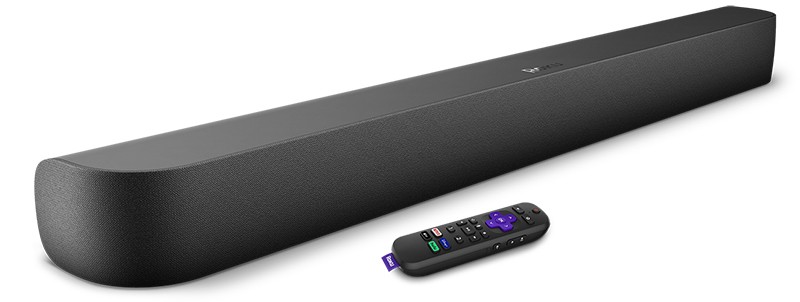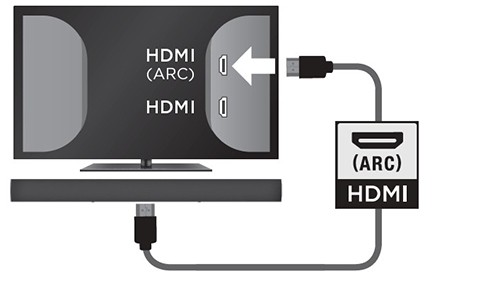How to set up your Roku Streambar Pro or Roku Smart Soundbar

Your Roku® Streambar® Pro or Roku Smart Soundbar is a 2-in-1 upgrade that adds both high definition 4K streaming and premium high quality audio to any TV. You can also add the same amazing sound to your TV's built-in tuner and enhance the audio experience of any other device connected to your TV, such as a Blu-ray™ player, game console, or cable set-top box. Just connect your streambar or soundbar to your TV with the included Premium High Speed HDMI® cable, connect your streambar or soundbar to the internet, and complete the easy setup process. You will be listening to powerful sound from all your entertainment sources in no time. For deeper, richer bass you can also add a Roku Wireless Bass or Roku Wireless Bass Pro. And, for immersive surround effects you can add Roku wireless speakers to the back of your room, or install a pair in the front of your room and another in the back for a full 5.1 surround sound experience.
There are two varieties of the product, both with the same exceptional audio quality and a streaming player built in. The onn.™ • Roku Smart Soundbar sold exclusively at Walmart (model 9100) includes a Roku simple remote, while the Roku Streambar Pro (model 9101R2) and Roku Smart Soundbar (model 9101) available from Roku.com and other retailers include a Roku voice remote with TV controls. This article describes both varieties in more detail and outlines the setup process whether you are connecting your Streambar or soundbar to a Roku TV™ or a non-Roku TV.
Will a Roku Streambar Pro or Roku Smart Soundbar work with my TV?
A Roku Streambar Pro or Roku Smart Soundbar will work with any television with an available HDMI port, but to simplify connections, we recommend using a special type of HDMI port called an ARC port. When using this port, you do not need to connect an additional cable to get audio from your TV (and connected devices) to your Streambar or soundbar. Instead, ARC (or Audio Return Channel) uses a single HDMI cable to send streaming video from the Streambar or soundbar to the TV, and audio from the TV (and connected devices) back to the Streambar or soundbar. Smart TVs manufactured in 2009 and later typically have one ARC port (among the other HDMI ports) commonly labeled "HDMI ARC" or "ARC". If another device is already using the ARC port, consider moving that device to a different HDMI port – only one device can be connected to the ARC port.
If your TV does not have an ARC port, you can still use a Streambar or soundbar to get exceptional sound from your TV's built-in tuner and other devices connected to your TV, but you will need to connect a second cable. In addition to the HDMI cable, you need to connect an optical cable to your TV's optical output, sometimes labeled "Digital audio out" or "Digital output". This connection carries TV audio to your Streambar or soundbar, while the HDMI connection delivers video from the streaming player in your Streambar or soundbar to the TV. If you need to use the optical port, visit the settings on your TV to make sure the output is active, or enabled.
- Note:
- Consult online documentation or the user manual for your TV if you are not sure your TV has an ARC port or need help finding settings for the optical port.
- When using an optical cable, be sure to remove the protective plastic cap from each end of the cable before inserting the connectors. Failing to do so may result in a faulty connection, or damage to the cable or optical port.
- You do not need to connect an optical cable when using the ARC port.
Do I need to adjust my TV settings?
If you are connecting your Streambar or soundbar to the ARC port, it is important you check the settings on your TV since ARC and related features may be disabled by default. If ARC is disabled, the ARC port will behave like a normal HDMI port and you will not hear audio from your TV (and connected devices) on your Streambar or soundbar.
You should also check the status of a related feature called HDMI-CEC (or just CEC) that helps simplify how you use your entertainment system. CEC allows commands to be shared between devices over the same HDMI connection you use for audio and video, letting you control common features of different devices without having to juggle remotes. If CEC is disabled, you will not be able to use your Streambar or soundbar remote to turn on or off your TV, or your TV remote to control volume on your Streambar or soundbar.
- Note: The power button on the remote for your Roku Streambar Pro or Roku Smart Soundbar works with most televisions. If your TV is not compatible, continue using your TV remote to turn your television on and off.
When you are looking for these settings on your TV, keep in mind that some manufacturers such as Hitachi and Vizio refer to ARC and CEC by their proper names, while others like LG, Panasonic, and Sony use brand-specific trade names. Some manufacturers even combine ARC and CEC into a single setting like Samsung's Anynet+. For help understanding the various trade names, review the detailed article describing how several popular TV brands go about enabling ARC and CEC.
Where to install your Streambar or soundbar
When you install your Roku Streambar Pro or Roku Smart Soundbar, it should be centered with the television screen to best anchor the sound to the picture. Whether you choose to simply place it on a piece of furniture in front of your TV, or mount it to the wall or directly to the TV (or TV bracket), avoid installing it where sound may reflect off a nearby flat surface like a TV stand, shelf, or table. Sound reflections like these combine with non-reflecting sound traveling directly from your Streambar or soundbar to negatively affect the sound-quality. The result is an effect known as comb filtering that makes what you hear less crisp and sharp, especially with higher frequencies like dialogue. This "muddy" sound can be avoided by installing your Streambar or soundbar using the guidelines below:
- Match the front edges: When placing your Streambar or soundbar on a piece of furniture, the front edge of the device should be flush with the front edge of any TV stand, shelf, or table. If your Streambar or soundbar is set back too far from the front edge of the flat surface, sound will reflect.
- Avoid enclosing your Streambar or soundbar: Avoid placing your Streambar or soundbar inside a closed space like a cabinet or TV stand. If you have no better alternative, make sure the front edge of your Streambar or soundbar is flush with the front edge of the shelf (inside the cabinet or TV stand).
- No obstructions: The area in front of your Streambar or soundbar should be free of objects such as picture frames, ornaments, plants, etc. High frequencies like dialogue are affected more by these obstructions than low frequencies.
- Mount it: If you do not have an ideal location on a piece of furniture, consider mounting your Streambar or soundbar.
Setup resources
If you need additional setup help, you can follow along with the appropriate tutorial video, or read one of the quick start guides below.
- Videos
Quick start guides
- Roku Streambar Pro (model 9101R2)
- Roku Smart Soundbar (model 9101)
- onn. • Roku Smart Soundbar (model 9100)
Connect your Streambar or soundbar
After you identify the ARC port and make sure ARC and CEC are enabled on your TV, use the steps below to connect your Streambar or soundbar.
- Use the included power cable and connect your Streambar or soundbar to a wall outlet, surge protector, or extension cord.
- With the included Premium High Speed HDMI Cable, connect your Streambar or soundbar to the ARC port on your TV.

- Note: If you did not check earlier, make sure ARC and CEC are enabled on your TV.
If you are not using ARC, use the Premium High Speed HDMI Cable to connect your Streambar or soundbar to any available HDMI port, and connect the included optical cable to the digital audio output on your TV.
After the connections are made and your soundbar powers on, make sure the correct input is selected on your TV (the input to which your Streambar or soundbar is connected). After a moment, you should see the Roku logo on your TV screen followed by an initial setup screen. If you do not see the logo, use your TV remote and double-check that the correct input is selected. Help is available if you do not see video on your TV.
On-screen setup and activation
The remaining portion of the setup process varies depending on the type of television your Streambar or soundbar is connected to. If you have a Roku TV you may be able to complete the automatic setup process. Choose the appropriate link below to continue with on-screen setup and activation.
- Your Streambar or soundbar is connected to a Roku TV
- Your Streambar or soundbar is connected to a non-Roku TV
If you are not sure what type of television you own, learn how to determine if you have a Roku TV.



